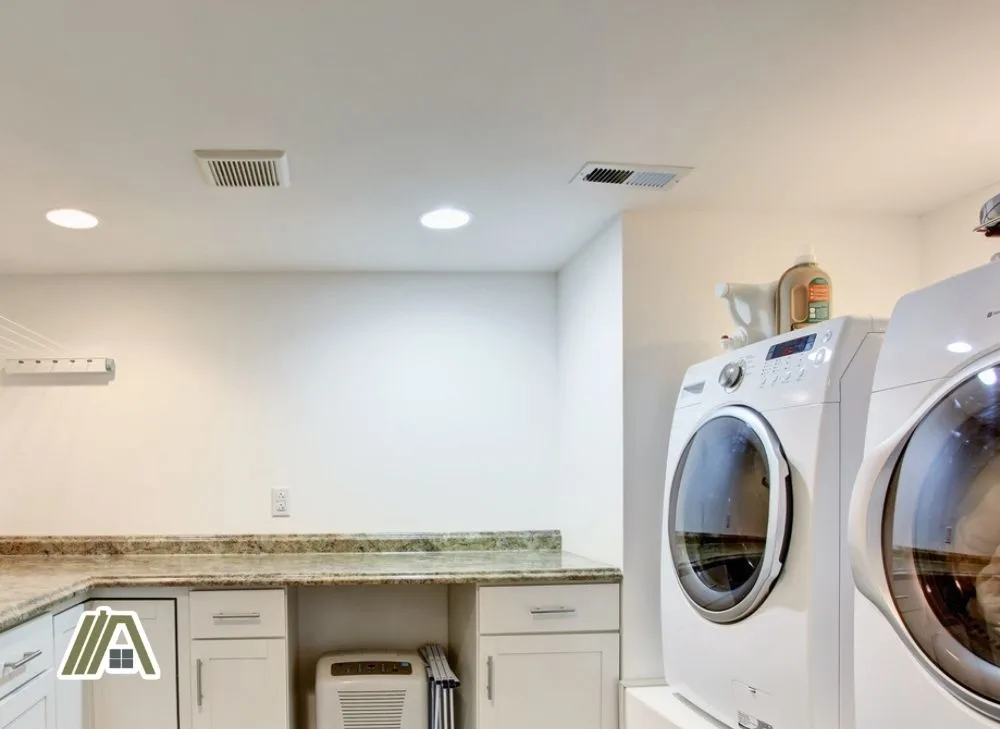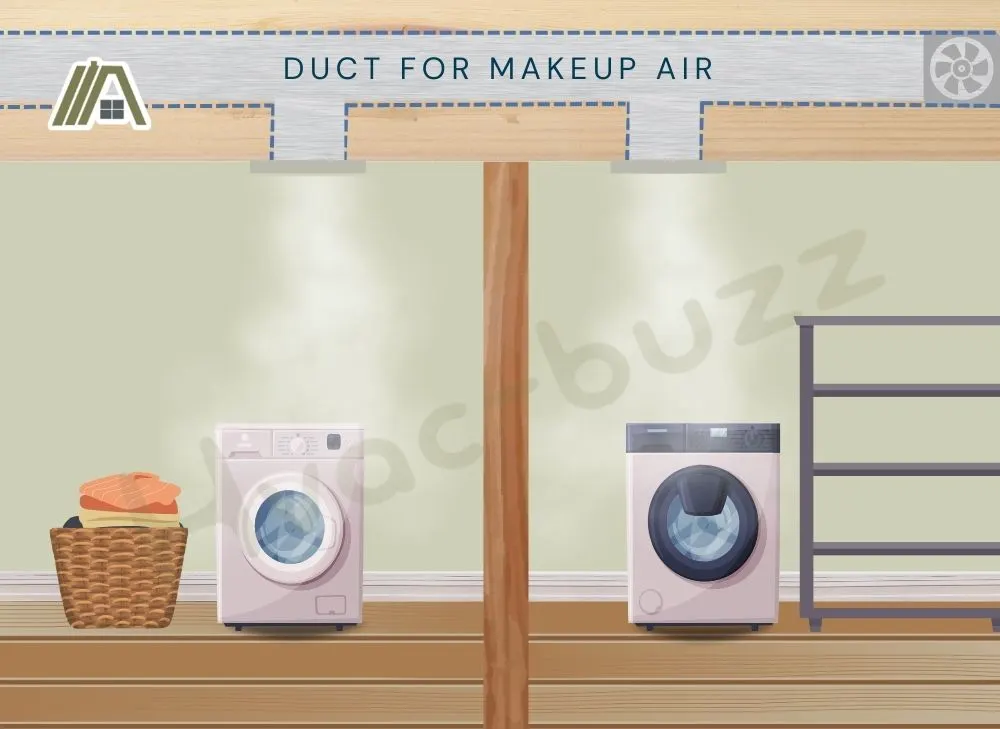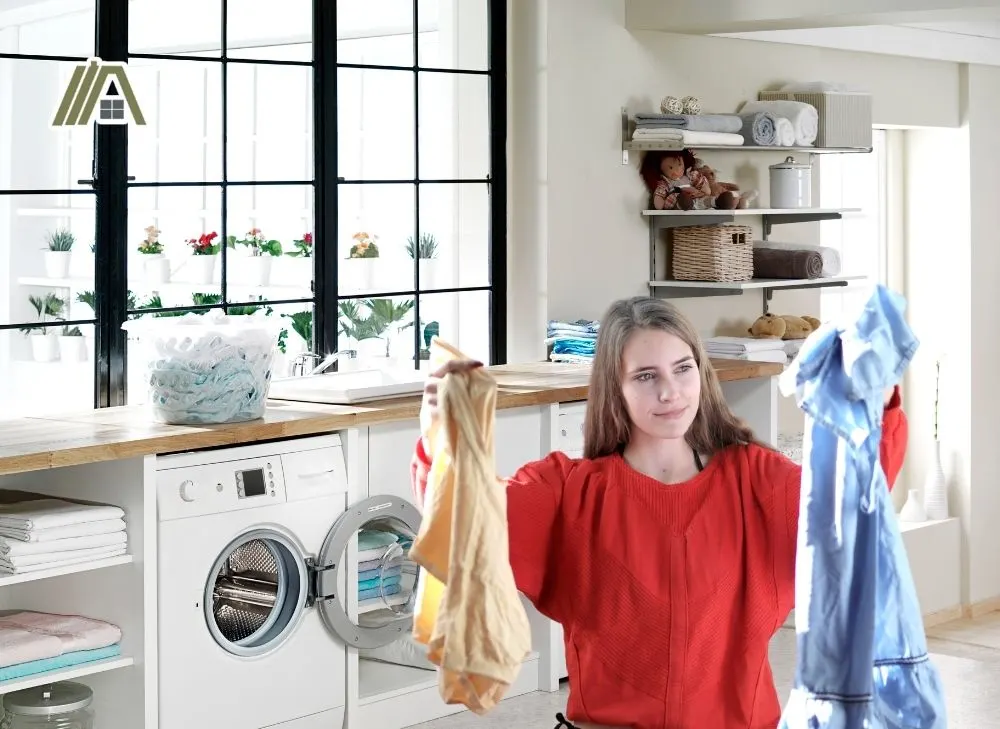A crucial function of makeup air is to prevent the backdrafting of combustion gases. This function causes confusion because many people then tend to associate the need for makeup air with combustion appliances, like furnaces and gas cookers.
However, makeup air is not provided for gas-burning appliances. It is provided for systems that actively exhaust air from a room—air that is not supplied to the appliance in the first place. Makeup air may be required for dryers, but it’s not because they can be gas-powered.

Makeup air is required when dryers exhaust enough air to interfere with the function of gas-fuelled appliances, including gas dryers. Dryers with exhaust rates of 200+ CFM need makeup air. Dryers in closets require makeup air.
Makeup Air Is Only Required for Vented Dryers
There are a variety of differences between vented and ventless dryers, and one of them is whether they require makeup air.
With vented dryers, air surrounding the appliance is pulled into the machine, heated, used to dry the clothes, and then released to the outside via ductwork.
As air is removed from the home by vented dryers, low-pressure systems develop around the machines, and replacement air must be supplied to re-establish a healthy pressure balance.
In some cases, the air is simply pulled from other rooms, open windows/doors, and even from cracks and gaps in the building structure without the need for intervention. You may not even be aware that it is happening.
However, when large amounts of air are vented out and need to be replaced, this infiltration of air may become noticeable and problematic. It may even prove to be insufficient.
In such cases, it is best to purposefully bring makeup air into your home. This can still be a passive process. The difference is that the pathway of travel is deliberately provided. It can also be active, using a fan to drive air into the house.

Ventless dryers also pull air in from the room surrounding the appliance. The difference is that this air is heated, run through the drum, filtered, cooled, condensed, re-heated, and passed through the drum again until the program is completed.
Once the program is completed or stopped by the user, the air is cooled, condensed, and filtered one last time before being released back into the room from which it was taken.
This means that the low-pressure system created at the start of the cycle remains small enough to be overcome through unnoticeable infiltration of air and it is also only temporary as the air is returned to the room. Makeup air is not required.
Now, vented dryers don’t always require makeup air. We can look to the International Residential Code (IRC) for an idea of when dryers start necessitating makeup air.
Gas dryers are an interesting study when it comes to makeup air because they combine an exhaust system with a combustion system.
When the Dryer Interferes With Appliance Function
According to Section G2407.4 of the IRC, one situation in which makeup air is required is when the exhaust-venting system of a clothes dryer interferes with the operation of an appliance.
In context, this is referring specifically to gas-powered appliances (Chapter 24 of the IRC is all about gas fuel).
So, interference with appliance operation would be when not enough air can be supplied to an appliance that needs it because of the air removed from the room.
Alternatively, it may be that the low-pressure system created causes the exhaust from gas appliances to be pulled into a room instead of removed via the appliance’s venting system.
A sufficient air supply and proper venting of combustion gases are both crucial to the effective and safe functioning of combustion appliances.
200+ CFM Dryers Require Makeup Air
According to Section G2439.5 of the IRC, clothes dryers that vent at a rate of 200 cubic feet per minute (CFM) or more must have makeup air. This is because at this rate, enough air is being removed from the room at a time to cause problems.
Most dryer vents are rated from about 100-250 CFM, so it is likely, but not guaranteed that you will purchase a dryer that qualifies for the introduction of makeup air to the room.
Additionally, if you live in a large household, own a bed and breakfast, or have more than one dryer for any reason, it is likely that you will have to introduce makeup air to the building, even if the dryers are each rated lower than 200 CFM.
If the summed total CFM of the dryers is more than 200 CFM, makeup air is required, unless you are positive that you will never run both dryers at once—but then what’s the point of having more than just one?
Rather than having a set CFM that must be supplied to the room via makeup air, the amount of makeup air must match the amount being vented out.

If your dryer is rated at 230 CFM, 230 CFM must be supplied to the home. If you have two dryers, one 130 CFM and one 120 CFM, 250 CFM must be supplied to the home.
However, this is not always as simple as it sounds. Some of the replacement air will come from the home’s natural infiltration, so a proper makeup air setup takes this into account.
This is why it is best to get a professional in to install it. You don’t want to pay more for a makeup air unit that supplies air at a rate exactly matching the dryer exhaust rate when you could have gotten a smaller one.
In the context of the IRC, this is a requirement if there are gas appliances present. This means that whether the dryer is gas-powered or electric makes no difference if there are other gas-fuelled appliances in the vicinity.
Dryers in Closets Need Makeup Air
Section G2439.5.1 of the IRC asserts that a smaller area meant for a dryer, often a closet, requires makeup air, but the room in which the closet is found does not.
This makeup air can be provided with a vent or even with a small opening into a room with a good air supply.
Any vented dryer, regardless of its CFM, must be provided with makeup air when in a closet. This is because closets, due to their small size, have a limited amount of air in the space, so depressurization of the space occurs more readily.
Check Local Requirements
The IRC is adopted by most states and territories in the US (with the exception of Wisconsin). However, there can be local changes to the IRC depending on local laws, climate, and other circumstances.
If your specific location has changes made to the IRC, these must be followed rather than the original code.
One example of alterations made to IRC guidelines is Nevada’s specific makeup air guidelines.
These guidelines detail the size of the openings for either residential (type 1) or commercial (type 2) dryers.
For type 1 dryers, Nevada’s code says to adhere to the manufacturer’s makeup air instructions. It also says that if the dryer is in a closet, a 100+ square inch opening must be provided for makeup air.
For type 2 dryers (just in case you happen to have a commercial dryer), the state code requires makeup air as provided by an opening of at least one square inch for every 1,000 BTU/hour (the heat rating of the dryer).
What Happens if There Is No Makeup Air?
I’ve mentioned that a lack of makeup air can interrupt the air supply to gas appliances and can also lead to the backdrafting of combustion gases. I also mentioned that these two side effects have a negative impact on appliance function and safety.
Let’s look at this in more detail.
If there is a vacuum in the room containing the dryer, then air cannot be pulled in properly. The result will be an overworked blower motor and damp clothing.

The dryer will have to extend the cycle to reach the required level of dryness (if this is how your dryer works), or you will have to run the same clothes for multiple cycles. Either way, this increases energy costs and wastes time.
Additionally, the uncontrolled airflow into the house initiated by the low-pressure system can cause drafts and can force your HVAC system to work overtime to condition the inflow of outside air.
There are two main safety hazards produced by a lack of makeup air and they can arise from any nearby gas appliance and the dryer itself if it is gas-powered.
The first risk is that of incomplete combustion.
Combustion is a reaction in which a hydrocarbon fuel (gas) burns in the presence of oxygen to produce heat, water (in the form of water vapor), and carbon dioxide. This is known as complete combustion)
When there is a deficiency of oxygen, the products of the reaction are heat (less than is produced during complete combustion), water vapor, and carbon monoxide.
As you know, carbon monoxide is potentially fatal and very difficult to detect. If your gas appliance is releasing carbon monoxide, then you are at risk of exposure.
Carbon monoxide can cause dizziness, shortness of breath, and weakness at low levels. At high levels, it can cause irreversible brain damage or death.
The second risk is that of backdrafting. The lower pressure in the room surrounding the gas appliance means that the air naturally gravitates into the room instead of being pulled out of it by the exhaust system.
Now, this is bad enough when it pulls carbon dioxide back inside. But when it’s pulling carbon monoxide into the room, it’s just a nightmare.
For more information, check out my article on Makeup Air | Here’s What Happens if You Don’t Have It
Sources
https://codes.iccsafe.org/content/IRC2021P2/chapter-24-fuel-gas#IRC2021P2_Pt06_Ch24_SecG2407.4
https://up.codes/s/provisions-for-makeup-air
https://www.nationalboard.org/index.aspx?pageID=164&ID=191
https://www.mayoclinic.org/diseases-conditions/carbon-monoxide/symptoms-causes/syc-20370642

Jos. Benkert
Monday 22nd of January 2024
Is make up air required for an electric cloths dryer in a closet in a building without gas appliances??
Michael Scott
Tuesday 23rd of January 2024
Hello there! If your dryer is vented in a small and airtight closet, you might need more makeup air .
Here's a simple way to check:
Turn on the dryer to the highest setting.
Wait for 5 minutes to ensure it's running properly. Slowly try to open the closet door. If it's hard to open due to air pressure, you need to add a grille to the door.
You can do a similar test with the exterior door. Just make sure all windows are closed.
If you have any questions, feel free to ask!